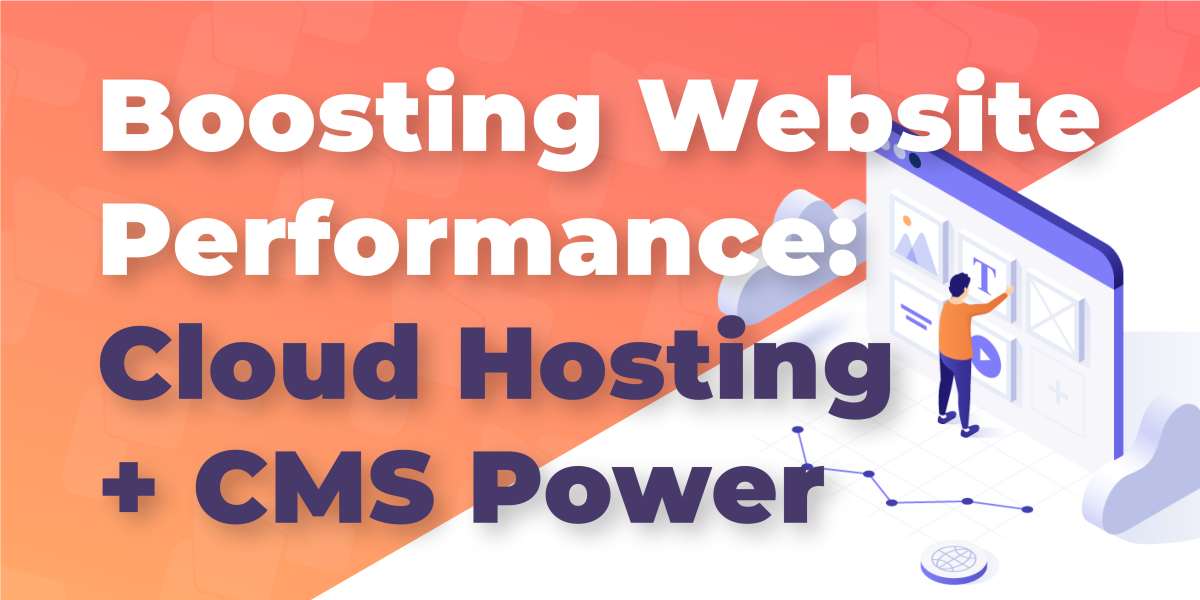Boosting Website Performance: Managed Cloud Hosting and Content Management Solutions Combined
Categories:
8 minutes reading

In the current digital economy, website performance is not just a technical consideration—it’s a foundational element of user experience, search engine visibility, and brand credibility. Slow load times, clunky interfaces, and unstable infrastructure cost more than customer loyalty; they erode trust, diminish conversions, and leave businesses vulnerable to competitors who prioritize speed and scalability.
At the center of this digital performance equation lies a powerful synergy between two critical technologies: managed cloud hosting and content management solutions. When integrated strategically, these tools do more than coexist—they compound each other’s strengths, enabling websites to perform faster, scale smarter, and deliver content with precision across a global audience.
This article unpacks the intricate interplay between these platforms, offering a technical lens on how their combined force enhances website performance at scale.
The Modern Performance Imperative
The average internet user expects a site to load in under three seconds. Anything beyond that increases bounce rates and drives visitors into the arms of faster competitors. Behind the scenes, milliseconds matter. Website speed directly impacts SEO rankings, ad quality scores, e-commerce conversion rates, and even user perception of professionalism and reliability. SEO audit and optimization are crucial components of ensuring that a website is performing at its best. By conducting regular audits and making necessary improvements, businesses can stay ahead of the competition and provide a seamless user experience that keeps visitors coming back for more.
While front-end optimizations like image compression or lazy loading help, real gains come from the architectural choices made at the infrastructure and CMS levels. And that’s where the integration of managed cloud hosting and robust content management solutions becomes a game-changer.
Understanding Managed Cloud Hosting

Managed cloud hosting abstracts the complexity of cloud infrastructure management, offering businesses a streamlined, secure, and scalable environment without needing in-house DevOps expertise. Instead of wrestling with server provisioning, performance tuning, patching, and security configurations, site owners rely on a dedicated team or provider to handle the heavy lifting.
What distinguishes managed cloud hosting from traditional hosting?
- Elastic scalability: Resources automatically adjust to handle traffic spikes.
- Distributed infrastructure: Applications and data are hosted across multiple nodes or regions for enhanced availability and fault tolerance.
- Performance optimization: Caching layers, CDN integrations, and load balancers come pre-configured.
- Security and updates: OS-level patches, firewalls, and threat monitoring are continuously maintained by the host.
This level of backend automation and tuning allows websites to operate at peak performance even during periods of high demand, seasonal traffic surges, or content delivery to international users.
Content Management Solutions: The Frontline of Experience

While managed cloud hosting provides the stable foundation, content management solutions are responsible for everything users see and interact with—from the blog article they read to the product catalog they browse.
A content management system (CMS) governs the way content is stored, presented, and updated across digital properties. Leading content management solutions like WordPress, Drupal, Joomla, and headless CMS platforms such as Strapi or Contentful are engineered to facilitate:
- Structured content delivery: Enabling reuse across multiple platforms and devices. Content creation and editing allow users to create and update content easily without technical knowledge.
- Authoring workflows: Allowing teams to collaborate, preview, and publish efficiently.
- Plugin architectures: Expanding capabilities with SEO tools, analytics, e-commerce integrations, etc.
- API extensibility: Allowing for custom frontend experiences in decoupled or headless configurations.
When performance begins to drag, the CMS is often the first suspect—and with good reason. Bloated themes, poorly coded plugins, and unoptimized database queries can all contribute to lag, even when hosted on powerful infrastructure. That’s why it’s not enough to choose a CMS for its features alone—it must also be optimized and well-matched to the underlying hosting environment.
The content management software market was valued at USD 31,707.0 million in 2024 and is expected to grow at a compound annual growth rate (CAGR) of 10.4% from 2025 to 2030, reaching USD 57,288.0 million. This growth is driven by the increasing need for businesses to manage and deliver content effectively across various digital platforms. As more companies prioritize user experience and SEO, the demand for optimized CMS solutions will continue to rise.
Where the Two Worlds Meet: Performance-First Architecture
A website’s performance is determined not by one component but by the efficiency of the system as a whole. Website features such as loading speed, responsiveness, and scalability are crucial in ensuring a positive user experience. By prioritizing performance-first architecture in content management systems, businesses can enhance their online presence and stay competitive in the digital landscape.
Managed cloud hosting and content management solutions must operate in concert, not conflict. Here’s how their integration drives measurable gains:
1. Dynamic Resource Allocation Meets Dynamic Content Delivery
A modern CMS is constantly querying databases, rendering dynamic pages, and interacting with APIs. On a shared or underpowered hosting environment, this leads to bottlenecks. Managed cloud hosting allocates resources dynamically, ensuring each query or page render has the memory and processing power it needs—even when multiple users are hitting the site simultaneously.
2. CDN + CMS Caching = Reduced Latency
Managed cloud providers often bundle content delivery networks (CDNs) like Cloudflare or BunnyCDN. Combined with smart CMS-level caching—like object caches in Redis or page caches via plugins—the result is near-instant content delivery from the edge. Instead of fetching every page from the origin server, static assets and even dynamic views are served from the nearest node.
3. Infrastructure-Aware CMS Optimization
Managed cloud environments often offer performance monitoring tools (e.g., New Relic, Datadog). When paired with CMS diagnostic tools (like Query Monitor for WordPress), teams can trace slow-loading elements to specific plugin calls, database queries, or API bottlenecks—and tune them accordingly. This visibility is key to maintaining performance as the site grows.
4. Global Performance, Localized Content
Many content-driven sites operate internationally. Managed cloud platforms with global data centers can host CMS content closer to end-users, improving performance and meeting data sovereignty regulations. Meanwhile, content management solutions can deliver personalized or translated content without having to replicate entire sites across regions.
Headless CMS and Serverless Hosting: The Future Frontier

The coupling of managed cloud hosting and CMS platforms is evolving rapidly. One of the most significant shifts is toward headless architecture, where the CMS handles content creation and storage, while the front end is delivered via decoupled frameworks like Next.js, Gatsby, or Nuxt.
In this model:
- The CMS serves content over APIs.
- The frontend is pre-rendered or dynamically rendered at the edge.
- Hosting is often serverless or edge-based, leveraging platforms like Vercel, Netlify, or AWS Lambda.
This approach drastically reduces page load times, improves developer flexibility, and scales seamlessly. Managed cloud hosting in this context includes not just virtual servers, but functions-as-a-service, object storage for assets, and automated builds/deployments triggered by CMS changes.
Case Study Logic: Why the Combination Matters
To understand the practical value of this integrated architecture, consider a typical e-commerce platform:
- It runs on WooCommerce (a CMS-based plugin on WordPress).
- Product listings are dynamically generated.
- Flash sales or seasonal campaigns drive unpredictable spikes in traffic.
Without managed cloud hosting, the site may crash or slow under load. Without a well-optimized CMS, even powerful servers can’t compensate for inefficient queries or bloated plugins. Together, however, they form a resilient system where traffic spikes are absorbed, and content is served without delay. The result? Higher conversion rates, reduced cart abandonment, and improved SEO performance.
Best Practices for Combined Optimization
To extract the full benefit of combining managed cloud hosting with content management solutions, organizations should consider the following:
- Select a CMS that matches the site’s complexity.
For blogs or marketing sites, a lightweight CMS like Statamic or Ghost may outperform WordPress. For enterprise-level content, headless platforms offer greater scalability. - Use managed hosting providers that specialize in your CMS.
Certain providers offer configurations, caching setups, and support teams tailored to WordPress, Drupal, or Magento. Avoid generic cloud hosting unless you have in-house DevOps. - Audit plugins and extensions regularly.
Even the best CMS can become sluggish if third-party tools introduce bloat or security flaws. Less is more—only install what you actively use. - Implement a layered caching strategy.
Use a combination of object caching (e.g., Redis), CDN caching, and page caching to reduce load on origin servers and database calls. - Monitor performance holistically.
Tools like Lighthouse, GTmetrix, and WebPageTest reveal frontend bottlenecks. Server-level logs and APM tools offer backend diagnostics. Insights from both are needed for effective optimization. - Automate scalability and updates.
Managed cloud environments should auto-scale based on traffic and provide one-click updates to core systems, minimizing manual intervention and downtime.
Security, Compliance, and Maintenance
While performance is the headline benefit, combining these technologies also addresses key operational concerns:
- Security patches are applied automatically in managed hosting environments, reducing CMS vulnerabilities.
- Data backups are performed at the infrastructure level, independent of CMS settings.
- Compliance with standards like GDPR or HIPAA is more achievable when both CMS and host can be configured to encrypt, anonymize, or store data within specific regions.
The joint ecosystem becomes not only faster but also safer and more sustainable for long-term growth.
Conclusion: Performance Is a System, Not a Feature
Website performance is no longer an afterthought—it’s a strategic asset that must be architected into every layer of the digital experience. By combining managed cloud hosting with purpose-fit content management solutions, businesses create an environment where content flows freely, infrastructure scales effortlessly, and users are never kept waiting.
As digital ecosystems continue to expand, the synergy between backend intelligence and frontend usability will define the winners and losers of the web. And in that equation, performance isn’t optional—it’s everything.